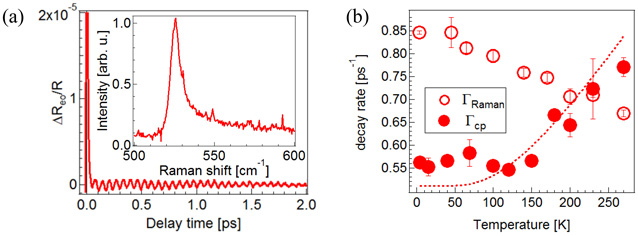Extraction of Phonon Decay Rate in p-type Silicon Under Fano Resonance
It is of primary importance to understand phonon dynamics in Si, not only for basic physics but also for obtaining ultrafast responses in semiconductor devices. Raman measurement is one of the experimental methods for determining phonon decay rates. However, in doped Si, especially p-type Si, an asymmetric lineshape appears due to Fano resonance, which makes it difficult to evaluate them [1]. In the present study, we performed time-resolved measurements to determine phonon decay rates free from the interaction with a continuum state in Fano resonance [2].
Time-resolved reflectivity measurements were performed with a sub-10-fs laser pulse, whose wavelength was centered on 780 nm. Figure 1(a) shows the time-resolved reflectivity of p-type Si. The p-type Si exhibits an asymmetric lineshape in the Raman measurement due to Fano resonance [inset in Fig. 1(a)]. The decay rate (Γcp) obtained from the time-resolved reflectivity is plotted as a function of temperature in Fig. 1(b), along with the Raman linewidths (ΓRaman). The temperature dependence of ΓRaman can be explained with the anharmonic decay model [3], but that of Γcp cannot be. The different temperature dependences between ΓRaman and Γcp could be explained by how the Fano resonance modifies the frequency- and time-domain spectra, respectively. The frequency-domain spectrum (i.e., Raman spectrum), on one hand, is broadened due to Fano resonance [1]. As a result, ΓRaman in the p-type Si deviates from the anharmonic decay model. The time-resolved response, on the other hand, is given by the summation of exponential decaying and deltalike responses, originating from the discrete (i.e., phonon) and continuum states, respectively [4]. The short decay time of the continuum state enables us to extract the exponentially phonon decay without any distortion. As a result, the temperature dependence of Γcp of the p-type Si reveals that the anharmonic decay model is dominant in p-type Si even under Fano resonance. We have shown that time-resolved measurements can extract discrete-state dynamics free from the interaction with the continuum state even under Fano resonance.
- [1] F. Cerdeira, T. A. Fjeldly, and M. Cardona, Phys. Rev. B 8, 4734 (1973).
- [2] K. Kato, K. Oguri, H. Sanada, T. Tawara, T. Sogawa, and H. Gotoh, AIP Advances 5, 097152 (2015).
- [3] T. R. Hart, R. L. Aggarwal, and B. Lax, Phys. Rev. B 1, 638 (1970).
- [4] C. Ott et al., Science 340, 716 (2013).

|
| Fig. 1. (a) Time-resolved reflectivity of p-type Si. The inset shows the Raman spectra of p-type Si. (b) Temperature dependence of the phonon decay rate. The solid and open symbols correspond to Γcp and ΓRaman, respectively. Dotted lines are the fits with the anharmonic decay models. |